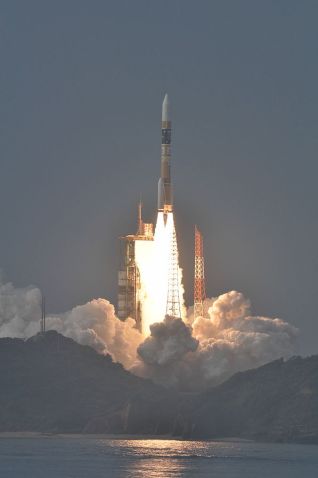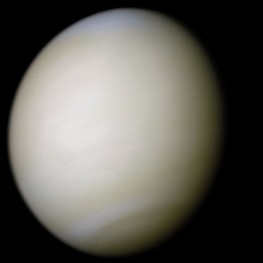On 7 December 2010, after a six month journey, the Japanese spacecraft Akatsuki (named after the Japanese word for dawn) arrived at Venus after a six month journey. It was only the second spacecraft launched since 1989 to visit the Earth’s sister planet and, if it had succeeded in orbiting Venus, it would have had been a tremendous boost for the Japanese space programme.
Launch of Akatsuki in May 2010 – Image from Wikimedia Commons
Unfortunately, when it arrived at Venus its main engine failed to fire properly to slow the spacecraft down and put it into orbit, so it shot past the planet and went into orbit around the Sun.
Venus as seen from Earth – Image from NASA
However all was not lost. Other than the main engines, all parts of the spacecraft turned out to be fully functioning, and the Japan Aerospace Exploration Agency (JAXA) will get a second chance to get Akatsuki into orbit when it passes close to Venus on Monday 7 December. This is very unusual for spacecraft which fail to go into orbit. Normally when a major mishap like this occurs the space agency doesn’t get a second chance.
How will the spacecraft get into orbit if its main engine has failed?
The thrust or force provided by rocket motors is usually measured in units called newtons, usually abbreviated to N. The main engine which failed to fire had a thrust of 500 N. To get the spacecraft into orbit JAXA will need to fire 4 of the 8 small rocket motors which were only designed to finely tune the spacecraft’s position. Each of these small motors only generates 20 N thrust and they will have to fire for a total of nearly 21 minutes to slow down the spacecraft to allow it go into orbit, something they were never designed to do. It is also fortunate that, unlike most spacecraft, the small rocket motors and the faulty main engine of the spacecraft use the same fuel, a liquid called hydrazine. If this was’t the case then this rescue operation would be impossible.
What will the spacecraft achieve?
Assuming the spacecraft successfully gets into orbit around Venus it has a whole host of instruments which will return useful data. Some of these are listed below:
- a special camera to study lightning flashes, which it will do when on the night side of Venus
- an instrument to study the structure of high-altitude clouds to enable us to understand more about Venus’s weather
- an ultraviolet camera to study the distribution of specific atmospheric gases such as sulfur dioxide in ultraviolet light, a form of light invisible to the naked eye
- an infrared defector which will peer through Venus’s atmosphere to see heat radiation emitted from Venus’ surface rocks and will help researchers to spot active volcanoes, if they exist.
Let’s all keep our fingers crossed for a success on December 7!
Akatsuki orbiting Venus – Image from JAXA




All digits crossed. A timely lesson in having multi-functional components. Must make a note of this for my SF stories. 😀
LikeLike
December 7th twice. Hmm. Hopefully this time a day which will not live in infamy.
LikeLike
Good luck, Akatsuki
LikeLike
Crossed fingers ready!
LikeLike